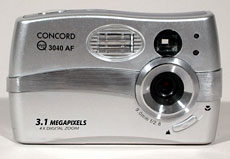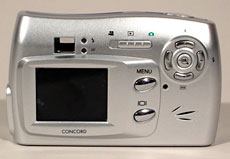Charles Moore's Mailbag
Concord Eye-Q 3040AF 3.1 Megapixel Digital Camera
Charles Moore - 2004.07.21 - Tip Jar
The Concord Eye-Q 3040AF digital camera is a 3.1 megapixel unit for the very attractive price of US$129.95, but does it deliver value with competitive features and image quality?
Concord, although not exactly a household name in the photography community, is a well-established manufacturer and global distributor of digital, instant, Advanced Photo System (APS), and 35 mm cameras. Concord's cameras are sold under Keystone, Le Clic, Goldline, Apex, Argus, Concord, Concord Eye Q, and Polaroid trademarks - the latter of which has plenty of name recognition and is used under license from Polaroid Corporation. The cameras are manufactured in Shenzhen, China.
On paper, the Concord Eye-Q 3040AF has pretty impressive specifications: a 3.1 megapixel CMOS sensor, 4x digital zoom (but no optical zoom), a 1.6" color backlit LCD, autofocus, 7 MB of internal memory, support for making AVI video clips, and macro mode for close-up photography. The camera also supports SD/MML memory cards (a popular memory expansion card format), has a 9.0 mm f/2.8 glass lens, and supports resolutions up to 2048 x 1536. There is a built-in flash with redeye reduction, a self-timer, an optical viewfinder, and a handy tripod socket.
Upon first impression, the Concord Eye-Q 3040 was attractive in appearance and seemed solidly constructed. One thing I really appreciate is that the camera comes with not one, but two printed manuals - a Quick Start Guide and a more detailed User's Guide with 50+ pages in English and Spanish (109 pages total).
|
|
|
Also bundled in the package are a wrist strap, a soft padded Neoprene (wet suit material) carry-case with Velcro closure, USB and video-out cables, and a pair of Duracell alkaline AA batteries.
Speaking of which, full credit Concord for choosing this no-hassle, inexpensive, standard battery. I detest specialized, proprietary, or oddball battery types in any sort of consumer electronics.
Both standard alkaline or rechargeable cells (NiCad or NiMH) are supported. As with any electronic camera that has an LCD display, the 3040AF eats up batteries fairly quickly, so rechargeables (which are officially supported) will be the economical choice, and it's wise to carry spares. There is a battery charge indicator in the digital readout.
With Macs, no additional software is necessary to support image downloads to your computer - true plug and play. Windows users aren't nearly so fortunate.
The camera's battery compartment, accessible through a panel on the bottom of the unit, also contains the slot for the optional memory expansion card, and SD cards up to 512 MB are supported. With the built-in 7 MB of memory, the number of shots you can store ranges from approximately 223 in the economy mode (512 x 384 resolution), to a mere five in fine quality mode (2048 x 1536/3.1 MP resolution). Striking a balance between image quality and capacity, normal mode at 3.1 megapixels allows 13 shots storage, and normal mode at 1600 x 1200 resolution (2 MP) allows 27 shots.
The camera's back and top are home to many controls, most of which are very small buttons that may be awkward to use if you have big fingers. I managed okay, but would prefer that the buttons were a bit larger.
The LCD display is flanked by menu selection and LCD on/off buttons, which are somewhat more generously sized, and there is a three-position slider switch to select the operational mode: still camera; video clip; or contents review. On top of the camera are an on-off power button and a two-stage shutter-release button.
The LCD monitor displays no less than 14 different icon readouts for a variety of functions, which are all tiny and not especially intuitive, but they do supply a lot of information once you learn to decipher them.
Navigation through menus and other selection functions are handled mainly by a north-south-east-west-center circular button cluster similar to those found on VCR remotes, only the buttons are in miniature.
The Eye-Q 3040AF is very determined not to let you inadvertently delete shots that you didn't intend to, so there is a lot of button-pushing to wade through yes/no confirmation dialogs.
Be prepared to spend a bit of time with the manual in order to learn to configure the camera. Once configured, just turn the camera on to take a picture in a single shot mode, then make sure it's set to Camera Mode and the Macro Mode switch beside the lens is set to Distant Mode (unless you happen to be taking a close-up shot of course). Frame the subject in the viewfinder or with the LCD. Press the shutter release halfway to activate the autofocus until the little green LED beside the viewfinder lights up. Then fully depress the shutter to take your picture. The camera will beep and make a soft click sound to indicate that the shot has been taken successfully.
Here we encounter my biggest frustration and annoyance with digital photography (at least affordable digital photography), shutter lag. Two or three seconds can elapse between the time you press the shutter release past the autofocus detent and when the beep sounds to signal that the shot has been taken. This shortcoming is not unique to the Eye-Q 3040AF; it afflicts all modestly priced digital cameras, but it is annoying and makes spontaneous quick shots impossible.
As an eyeglass-wearer, I found the optical viewfinder less than satisfactory, although this is a standard complaint with this type of viewfinder and not specific to this particular camera model.
You can use the autofocus lock function to freeze the focus when the main subject is not located at the center of the picture, and the digital zoom offers up to 4x magnification, which can be monitored in the LCD. Here is the zoom set at its widest (normal) angle and zoomed at 4x:

You can fine tune picture appearance for quality and resolution, scene selection (party/indoor; beach/snow; night portraits), and white balance, as well as image quality (JPEG compression) and resolution. Macro mode allows you to take close-ups at an optimum distance of 7.9" (20 cm).
For taking video clips, you will want more memory than the built-in 7 MB. You can review your video clips in the LCD monitor or connect the camera to a television using the video cable provided
Still photos can also be reviewed in the LCD as either individual (including enlarged image) or thumbnail modes. You can, of course, download them to your computer for storage and then create albums, post them on the Internet, email them to friends, and enhance them using image editing software.
If you have a PowerPC Mac with USB running Mac OS 9.0 or later, you're good to go. No software driver installation whatsoever is necessary. Pure plug and play.
Fully 12 pages of the 52 page User's Guide are taken up with instructions for how to install and use the required software for Windows support, and you can skip the whole thing. Smugness is unavoidable.
Just plug the provided USB cable into a USB port, power on the camera, plug the other end of the cable into the camera's USB port, and in a few seconds a hard drive icon will appear on your Mac's Desktop. Click the hard drive icon, then the DC112 file, and then the 100_3040 file, and voilà! There you will find the picture files stored in your camera, and you can select and drag any or all of them to whatever destination on your hard drive suits you.
When you're done downloading your images, eject the camera "Hard Drive", unplug the cable, and you're finished. I found that it worked flawlessly in both OS X 10.3.2 on my Pismo PowerBook, and in OS 9.0 through a Macally USB PC Card adapter on my old WallStreet PowerBook. Slick. This little camera is very Mac-friendly.
I was pleased with the picture quality rendered by the Eye-Q 3040 AF, although the results directly from the camera tend to have a bit of a blue/greenish cast. Here are an uncorrected shot and an improved image after applying Photoshop Elements 2.0's auto contrast and color correction commands:

Here's another before-and-after shot:

The effect is particularly noticeable in these examples taken on an overcast day, but it is a consistent issue. It doesn't really bother me, because I correct the contrast and color of every photo, including digitalized scans of shots made with my film cameras, but it may bug you if you aren't into image editing.
In general, I quite like the Concord 3040. It works well, is loaded with features, and doesn't cost a whole lot.
What's not to like? Well, there are those tiny buttons, the eyeglasses-unfriendly viewfinder, shutter-lag, and that color-cast, but those gripes would apply to a wide variety of digital cameras, not just this one.
Oh, and I wish there was a socket for a cable release, which would make tripod-mounted use more convenient.
Concord Eye-Q 3040AF Specs
- 3.1 Megapixels, 2048 x 1536 maximum resolution
- 1.6" TFT color LCD display
- 7 MB internal memory, SD/MMC card slot
- AVI movie, 15 fps at QVGA
- 4x digital zoom
- video clip recording capability
- macro mode
- 3 preset scenes
- Compatible with Windows 98SE/2000/ME/XP and Mac OS 9.0 and higher
- MSRP $129.99
Concord cameras are available at major retailers.
Join us on Facebook, follow us on Twitter or Google+, or subscribe to our RSS news feed
Charles Moore has been a freelance journalist since 1987 and began writing for Mac websites in May 1998. His The Road Warrior column was a regular feature on MacOpinion, he is news editor at Applelinks.com and a columnist at MacPrices.net. If you find his articles helpful, please consider making a donation to his tip jar.
Links for the Day
- Mac of the Day: PowerBook 2300, introduced 1995.08.28. The only Duo equipped with a PowerPC processsor run at 100 MHz.
- Support Low End Mac
Recent Content
About LEM Support Usage Privacy Contact
Follow Low End Mac on Twitter
Join Low End Mac on Facebook
Favorite Sites
MacSurfer
Cult of Mac
Shrine of Apple
MacInTouch
MyAppleMenu
InfoMac
The Mac Observer
Accelerate Your Mac
RetroMacCast
The Vintage Mac Museum
Deal Brothers
DealMac
Mac2Sell
Mac Driver Museum
JAG's House
System 6 Heaven
System 7 Today
the pickle's Low-End Mac FAQ
Affiliates
Amazon.com
The iTunes Store
PC Connection Express
Macgo Blu-ray Player
Parallels Desktop for Mac
eBay



